Effect of Mechanical Vibration on the Mechanical Properties and Solidification Feeding in Low-Pressure Sand Casting of Al-Cu-Mn-Ti Alloy
Abstract
1. Introduction
2. Materials and Methods
2.1. Chemical Analysis of Alloy
2.2. Casting Setup
2.3. Experimental Scheme
2.4. Metallurgical Characterizations
2.4.1. Density Measurement
2.4.2. Shrinkage Porosity Evaluation
2.4.3. Microstructure Evaluation
2.4.4. Mechanical Property Test
3. Results and Discussions
3.1. Harmonic Response of the Casting System
3.2. Visual Observation
3.3. Shrinkage Defects and Density Variation
3.4. Microstructural Observation
3.5. Mechanical Properties
3.6. Effect of Mechanical Vibration on the Solidification Feeding in the LPSC
3.6.1. Mass Feeding
3.6.2. Interdendritic Feeding
3.6.3. Burst Feeding
4. Conclusions
- Applying a suitable vibration, such as the resonant vibration, was more effective than increasing solidification pressure in improving solidification feeding of the LPSC, while the most effective method was applying both simultaneously, which eliminated the shrinkage defects and increased the density by 2.7%.
- By applying resonant vibration and increasing the solidification pressure simultaneously, metallurgical features such as the average values of the primary α-Al grain size and average density reduced by 29.5% and increased by 2.7%, respectively; the mechanical properties, such as ultimate tensile strength and percentage elongation increased by 21.7% and 7.8%, respectively, as compared with low solidification pressure and stationary casting.
- Mechanical vibration was conducive to mass feeding by refining the primary α-Al grains, to interdendritic feeding by reducing the threshold pressure gradient, and to burst feeding by collapsing the barrier.
Author Contributions
Funding
Institutional Review Board Statement
Informed Consent Statement
Data Availability Statement
Conflicts of Interest
References
- Zhang, M.; Zhang, W.W.; Zhao, H.D.; Zhang, D.T.; Li, Y.Y. Effect of Pressure on Microstructures and Mechanical Properties of Al-Cu-based Alloy Prepared by Squeeze Casting. T. Nonferr. Metal. Soc. 2007, 17, 496–501. [Google Scholar] [CrossRef]
- Mi, G.; Wang, K.; Gong, H.; Wang, H.; Zeng, S. Microstructure and Properties of ZL205 Alloy. China Foundry 2008, 5, 24–27. [Google Scholar]
- Wang, Y.; Hu, M.; Xu, H.; Ji, Z.; Wen, X.; Liu, X. Effect of Isothermal Process Parameters on Semi-Solid Microstructure of Chip-Based Al-Cu-Mn-Ti Alloy Prepared by SIMA Method. Mod. Phys. Lett. B 2020, 34, 2050385. [Google Scholar] [CrossRef]
- Geng, H.; Cui, C.; Liu, L.; Liang, Y. The Microstructures and Mechanical Properties of Hybrid In-Situ AlN-TiC-TiN-Al3Ti/Al Reinforced Al-Cu-Mn-Ti Alloy Matrix Composites. J. Alloy. Compd. 2022, 903, 163902. [Google Scholar] [CrossRef]
- Guo, T.; Wang, B.; Zhang, Z.; Sun, Q.; Jin, Y.; Ding, W. Effect of Micro-Scale Er on the Microstructure and Fluidity of ZL205A Alloy. Materials 2019, 12, 1688. [Google Scholar] [CrossRef] [PubMed]
- Wu, S.P.; Wang, R.J.; Wang, Y.; Chen, W.; Ji, Z.S. Reduction of Shrinkage Porosities in Aluminum Alloy Castings by External Pressure Fluctuation Under Gravity Field. China Foundry 2018, 15, 372–377. [Google Scholar] [CrossRef]
- Wang, Y.; Wu, S.; Xue, X.; Chen, R.; Zhang, J.; Xiao, W. Experimental and Numerical Study on Formation Mechanism of Linear Macro-Segregation in Low-Pressure Die Casting of Al-Cu-Mn-Ti Alloy. Proc. Inst. Mech. Eng., Part C 2017, 231, 1946–1955. [Google Scholar] [CrossRef]
- Luo, L.; Xia, H.Y.; Luo, L.S.; Su, Y.Q.; Cai, C.J.; Wang, L.; Guo, J.J.; Fu, H.Z. Eliminating Shrinkage Defects and Improving Mechanical Performance of Large Thin-Walled ZL205A Alloy Castings by Coupling Travelling Magnetic Fields with Sequential Solidification. T. Nonferr. Metal. Soc. 2021, 31, 865–877. [Google Scholar] [CrossRef]
- Li, B.; Shen, Y.F.; Hu, W.Y. Casting Defects Induced Fatigue Damage in Aircraft Frames of ZL205A Aluminum Alloy—A Failure Analysis. Mater. Des. 2011, 32, 2570–2582. [Google Scholar] [CrossRef]
- Xu, B.; Rui, Z.Y. Moldflow-Based Optimization Design of Gating System in Injection Mold for Automobile Bumper. Adv. Mater. Res. 2014, 1061–1062, 465–470. [Google Scholar] [CrossRef]
- Sowa, L.; Skrzypczak, T.; Kwiatoń, P. Numerical Evaluation of the Impact of Riser Geometry on the Shrinkage Defects Formation in the Solidifying Casting. Arch. Metall. Mater. 2022, 67, 181–187. [Google Scholar]
- Zhang, J.Y.; Zuo, L.J.; Feng, J.; Ye, B.; Kong, X.Y.; Jiang, H.Y.; Ding, W.J. Effect of Thermal Exposure on Microstructure and Mechanical Properties of Al-Si-Cu-Ni-Mg Alloy Produced by Different Casting Technologies. T. Nonferr. Metal. Soc. 2020, 30, 1717–1730. [Google Scholar] [CrossRef]
- Alexandrov, D.V.; Galenko, P.K. Dendrite Growth Under Forced Convection: Analysis Methods and Experimental Tests. Phys.-Usp. 2014, 57, 771–786. [Google Scholar] [CrossRef]
- Wang, R.J.; Wu, S.P.; Chen, W. Mechanism of Burst Feeding in ZL205A Casting Under Mechanical Vibration and Low Pressure. T. Nonferr. Metal. Soc. 2018, 28, 1514–1520. [Google Scholar] [CrossRef]
- Wang, Y.; Wu, S.P.; Niu, L.J.; Xue, X.; Zhang, J.B.; Xiao, W.F. Optimization of Low-Pressure Die Casting Process Parameters for Reduction of Shrinkage Porosity in ZL205A Alloy Casting Using Taguchi Method. Proc. Inst. Mech. Eng. Part B 2014, 228, 1508–1514. [Google Scholar]
- Hou, Y.; Zhou, R.; Long, X.; Liu, P.; Fu, Y. The Design and Simulation of New Downhole Vibration Device About Acoustic Oil Recovery Technology. Petroleum 2015, 1, 257–263. [Google Scholar] [CrossRef][Green Version]
- Guan, F.; Fan, S.; Wang, J.; Li, G.; Zhang, Z.; Jiang, W. Effect of Vibration Acceleration on Interface Microstructure and Bonding Strength of Mg-Al Bimetal Produced by Compound Casting. Metals 2022, 12, 766. [Google Scholar] [CrossRef]
- Promakhov, V.V.; Khmeleva, M.G.; Zhukov, I.A.; Platov, V.V.; Khrustalyov, A.P.; Vorozhtsov, A.B. Influence of Vibration Treatment and Modification of A356 Aluminum Alloy on its Structure and Mechanical Properties. Metals 2019, 9, 87. [Google Scholar] [CrossRef]
- Selivorstov, V.; Dotsenko, Y.; Borodianskiy, K. Influence of Low-Frequency Vibration and Modification on Solidification and Mechanical Properties of Al-Si Casting Alloy. Materials 2017, 10, 560. [Google Scholar] [CrossRef]
- Yadav, S.; Tewari, S.P.; Singh, J.K.; Ram, S.C. Effects of Mechanical Vibration on the Physical, Metallurgical and Mechanical Properties of Cast A308 (LM21) Aluminum Alloy. Int. J. Min. Met. Mater. 2022, 29, 1206–1215. [Google Scholar] [CrossRef]
- Jiang, W.M.; Chen, X.; Wang, B.J.; Fan, Z.T.; Wu, H.B. Effects of Vibration Frequency on Microstructure, Mechanical Properties, and Fracture Behavior of A356 Aluminum Alloy Obtained by Expendable Pattern Shell Casting. Int. J. Adv. Manuf. Technol. 2016, 83, 167–175. [Google Scholar] [CrossRef]
- Pîrvulescu, C.M.; Bratu, C. Mechanic Vibrations Generation System and Effect on the Casting Alloys Solidification Process. UPB. Sci. Bull. Ser. B 2010, 72, 219–232. [Google Scholar]
- Kocatepe, K.; Burdett, C.F. Effect of Low Frequency Vibration on Macro and Micro Structures of LM6 Alloys. J. Mater. Sci. 2000, 35, 3327–3335. [Google Scholar] [CrossRef]
- Zhao, Z.; Fan, Z.T. Influence on the Microstructures and Properties of A356 with Vibration Pressure in Lost Form Casting. Appl. Mech. Mater. 2014, 685, 7–10. [Google Scholar] [CrossRef]
- Chen, W.; Wu, S.P.; Wang, R.J. Effect of Vibration on Interdendritic Feeding of Al-5%Cu-0.4%Mn Alloy. Int. J. Metalcast. 2019, 13, 969–978. [Google Scholar] [CrossRef]
- Campbell, J. Effects of Vibration During Solidification. Int. Met. Rev. 1981, 26, 71–108. [Google Scholar] [CrossRef]
- Hu, Y.J.; Wang, J.Y.; Xu, N.X.; Zhai, W.; Wei, B. Three Orthogonally Arranged Ultrasounds Modulate Solidification Microstructures and Mechanical Properties for AZ91 Magnesium Alloy. Acta Mater. 2022, 241, 118382. [Google Scholar] [CrossRef]
- Zhao, Y.; He, W.; Song, D.; Shen, F.; Li, X.; Sun, Z.; Wang, Y.; Liu, S.; Du, Y.; Fernández, R. Effect of Ultrasonic Melt Processing and Al-Ti-B on the Microstructural Refinement of Recycled Al Alloys. Ultrason. Sonochem. 2022, 89, 106139. [Google Scholar] [CrossRef]
- Lu, G.; Chen, Y.; Yan, Q.; Huang, P.; Zhan, H.; Duan, Y. Effects of Continuous and Pulsed Ultrasonic Treatment on Microstructure and Microhardness in Different Vertical Depth of ZL205A Castings. Materials 2020, 13, 4240. [Google Scholar] [CrossRef]
- Kong, L.G. Effect of Mechanical Vibration on Shrinkage of ZL205A Alloy Castings by Low-Pressure Casting Process; Harbin Institute of Technology: Harbin, China, 2014. [Google Scholar]
- Jiang, W.M.; Fan, Z.T.; Dai, Y.C.; Li, C. Effects of Rare Earth Elements Addition on Microstructures, Tensile Properties and Fractography of A357 Alloy. Mater. Sci. Eng. A 2014, 597, 237–244. [Google Scholar] [CrossRef]
- Lian, W.; Wei, B.; Fan, J.H. Changing Hot Spot of Casting and the Position Relationship Between Riser and Hot Spot. Foundry Technol. 2004, 25, 811–812. [Google Scholar]
- Taga, K.; Fukui, Y.; Tsunekawa, Y.; Okumiya, M. Crystallization of Non-Equilibrium α-Aluminum Solid Solution in Al-18mass%Si Alloy Through Acoustic Cavitation. J. Jfs 2009, 81, 469–474. [Google Scholar]
- Ohsawa, Y.; Sato, A.; Namai, T.; Aragane, G. Application Modes of Ultrasonic Vibration to Molten Metal and Their Effect on Solidification Structures. IMONO 1993, 65, 288–293. [Google Scholar]
- Omura, N.; Murakami, Y.; Li, M.; Tamura, T.; Miwa, K.; Furukawa, H.; Harada, M. Effects of Mechanical Vibration on Cooling Rate and DAS of AC4C Aluminum Alloy Gravity Die Castings. Mater. Trans. 2009, 50, 2604–2608. [Google Scholar] [CrossRef]
- Chirita, G.; Stefanescu, I.; Soares, D.; Silva, F.S. Influence of Vibration on the Solidification Behaviour and Tensile Properties of an Al-18wt%Si Alloy. Mater. Des. 2009, 30, 1575–1580. [Google Scholar] [CrossRef]
- Kocatepe, K. Effect of Low Frequency Vibration on Porosity of LM25 and LM6 Alloys. Mater. Des. 2007, 28, 1767–1775. [Google Scholar] [CrossRef]
- Osawa, Y.; Takamori, S.; Kimura, T.; Minagawa, K. Control of Segregation and Solidification Structure in Al-Si-Fe Alloy by Ultrasonic Vibration. J. Jfs 2007, 79, 738–744. [Google Scholar]
- Kumar, R.; Ansari, M.S.; Mishra, S.S.; Kumar, A. Effect of Mould Vibration on Microstructure and Mechanical Properties of Casting During Solidification. Int. J. Eng. Res. 2014, 3, 90–92. [Google Scholar]
- Wu, X.Y.; Yun, Y.; Zhang, H.R.; Ma, Z.; Jia, L.N.; Tao, T.X.; Zhang, H. Effect of Holding Pressure on Microstructure and Fracture Behavior of Low-Pressure Die Cast A356-T6 Alloy. Mater. Res. Express 2017, 4, 126501. [Google Scholar] [CrossRef]
- Yan, X.J.; Tan, P.; Sui, Y.D.; Jiang, Y.H.; Wang, Q.D. Effects of Different Holding Pressures on the Microstructure and Mechanical Properties of Al-5.9Zn-2.2Mg-1.8Cu Alloy. J. Alloy. Compd. 2022, 894, 162367. [Google Scholar] [CrossRef]
- Yoshitake, Y.; Yamamoto, K.; Sasaguri, N.; Era, H. Refinement of Primary Si Grains of Al-21%Si Alloy Using Vibration Mold. Mater. Trans. 2020, 61, 355–360. [Google Scholar] [CrossRef]
- Campbell, J. Castings, 2nd ed.; Butterworth-Heinemann: Oxford, UK, 1991; pp. 205–231. [Google Scholar]
- Li, Q.C.; Chen, K.Y.; Zeng, S.Y. Influence of Rare Earth Additions on Rheological Behaviour of Al-5Cu Alloy in Solid-Liquid Coexistence Zone. Mater. Sci. Tech. 1991, 7, 770–774. [Google Scholar]
- Dai, G.X.; Wu, S.P.; Chen, W.; Huang, X.X. Mechanism of P-wave Promoting the Solidification Feeding in the Low-Pressure Casting of ZL205A Alloy. Int. J. Cast Metal. Res. 2020, 33, 177–183. [Google Scholar] [CrossRef]
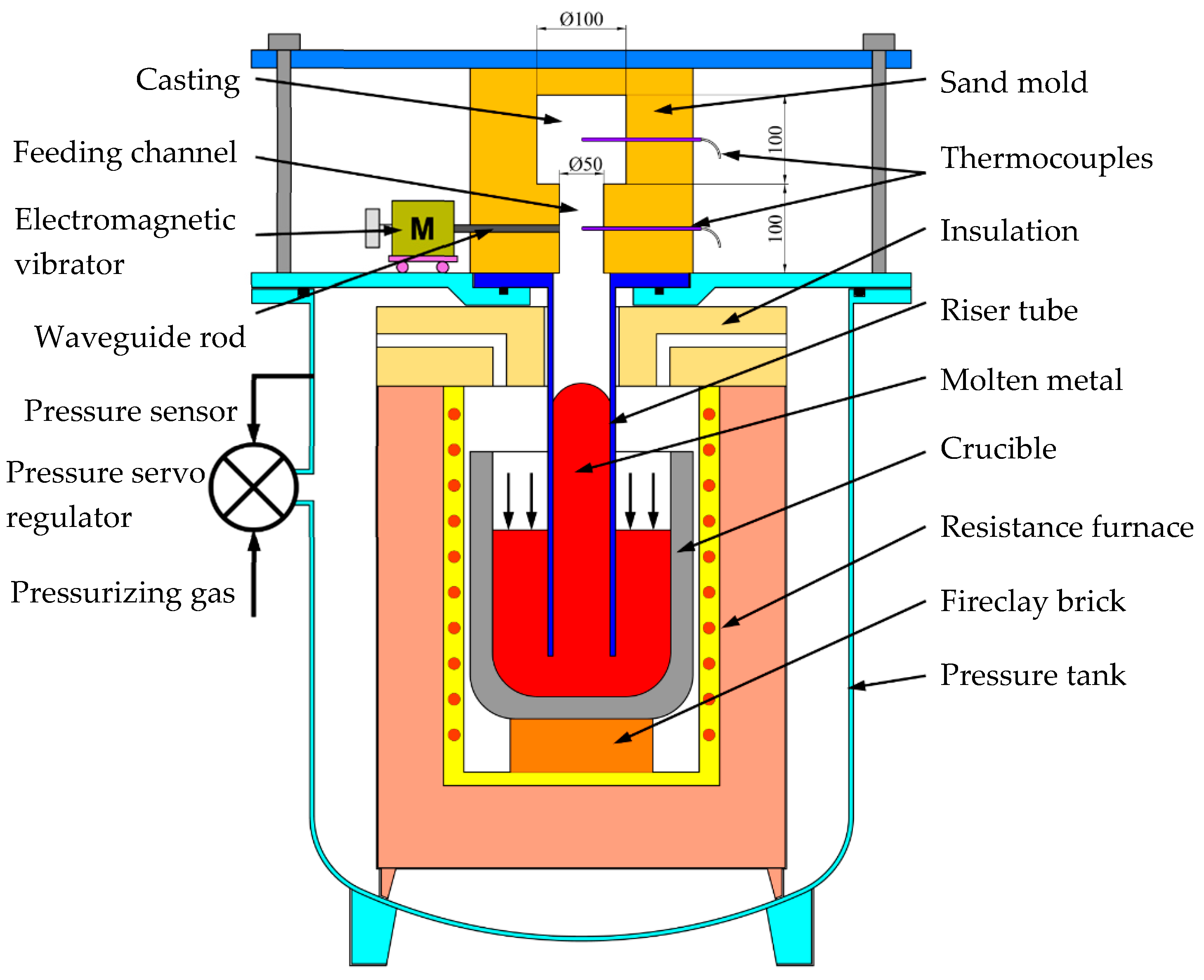
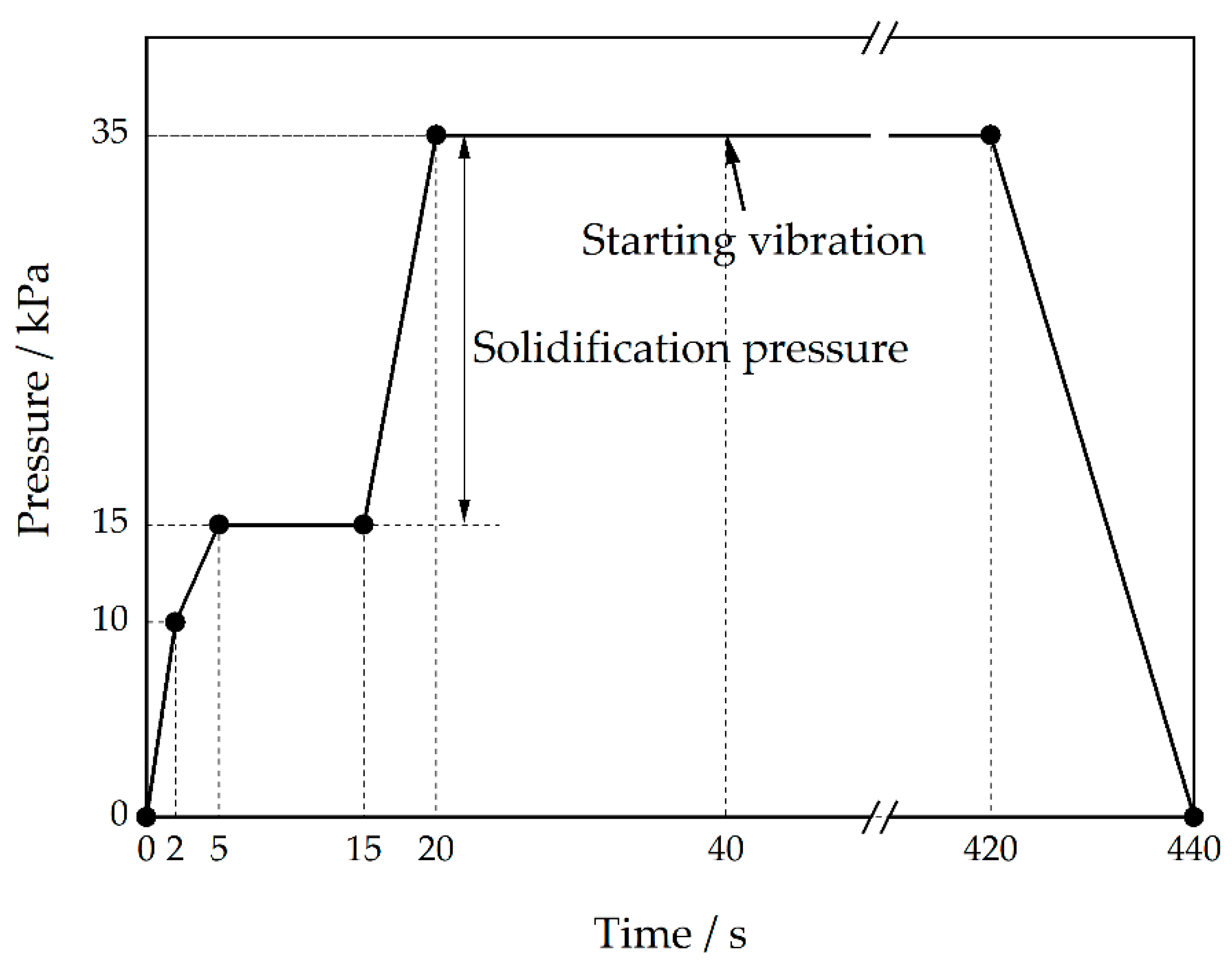

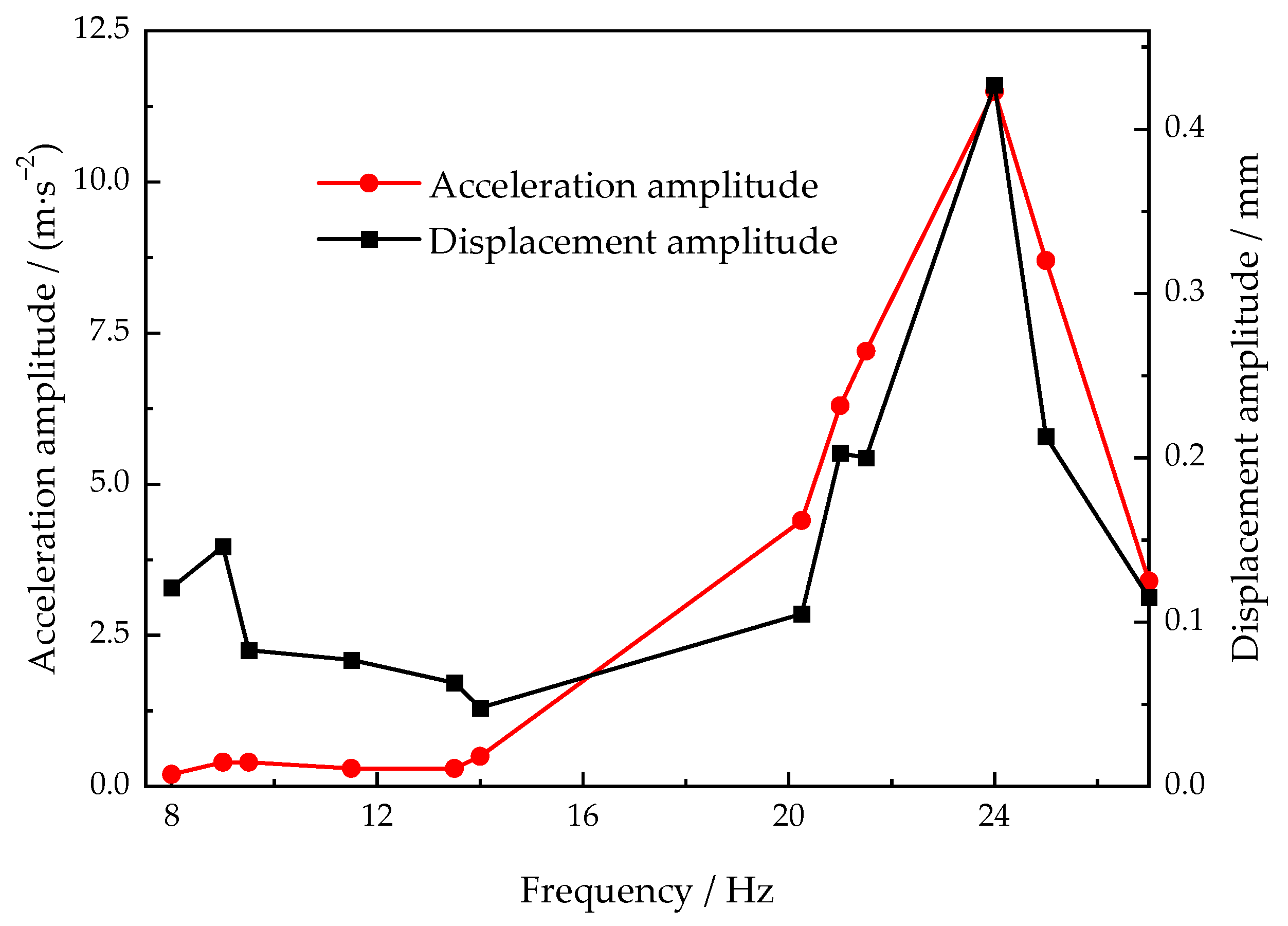
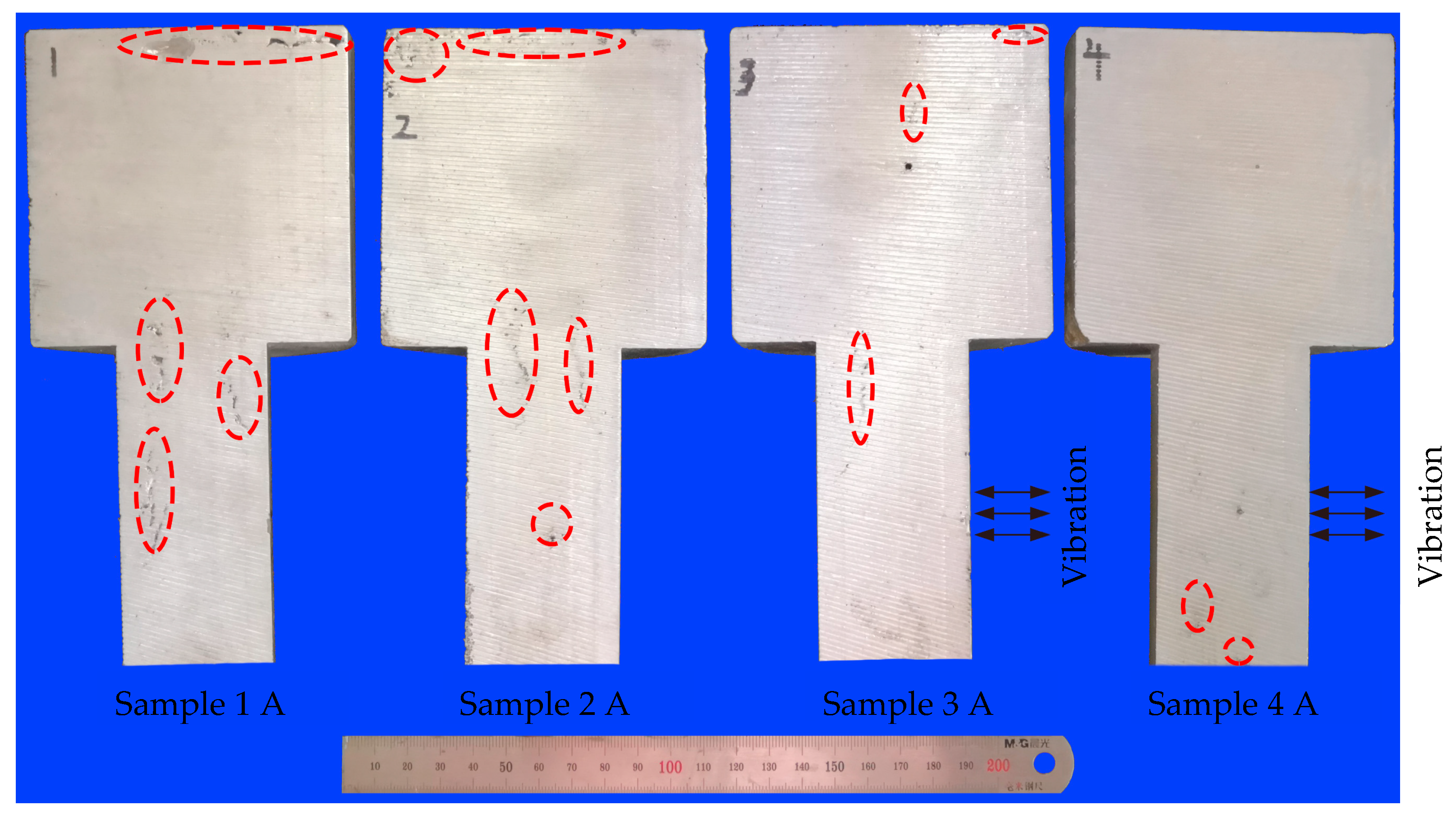
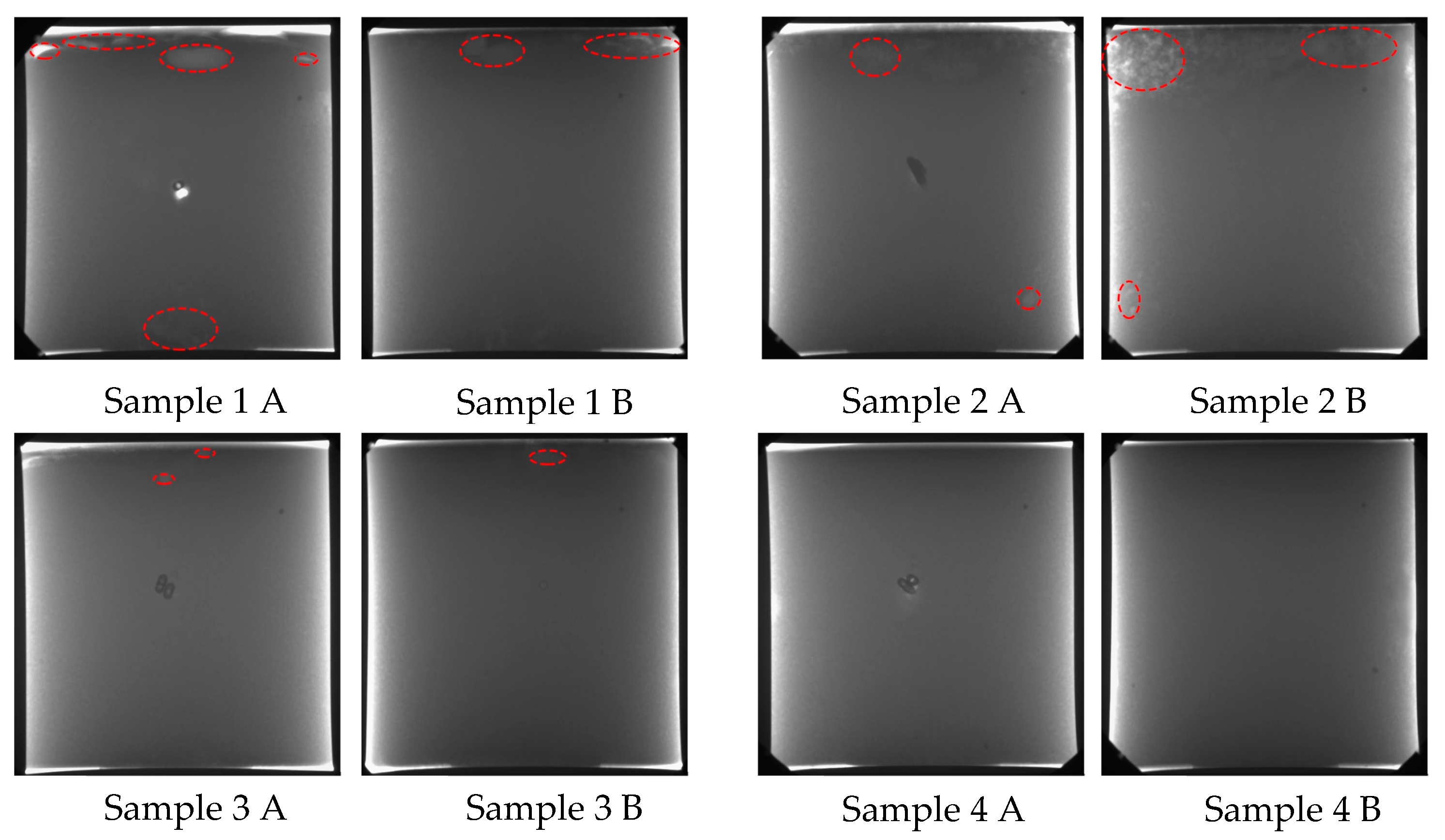


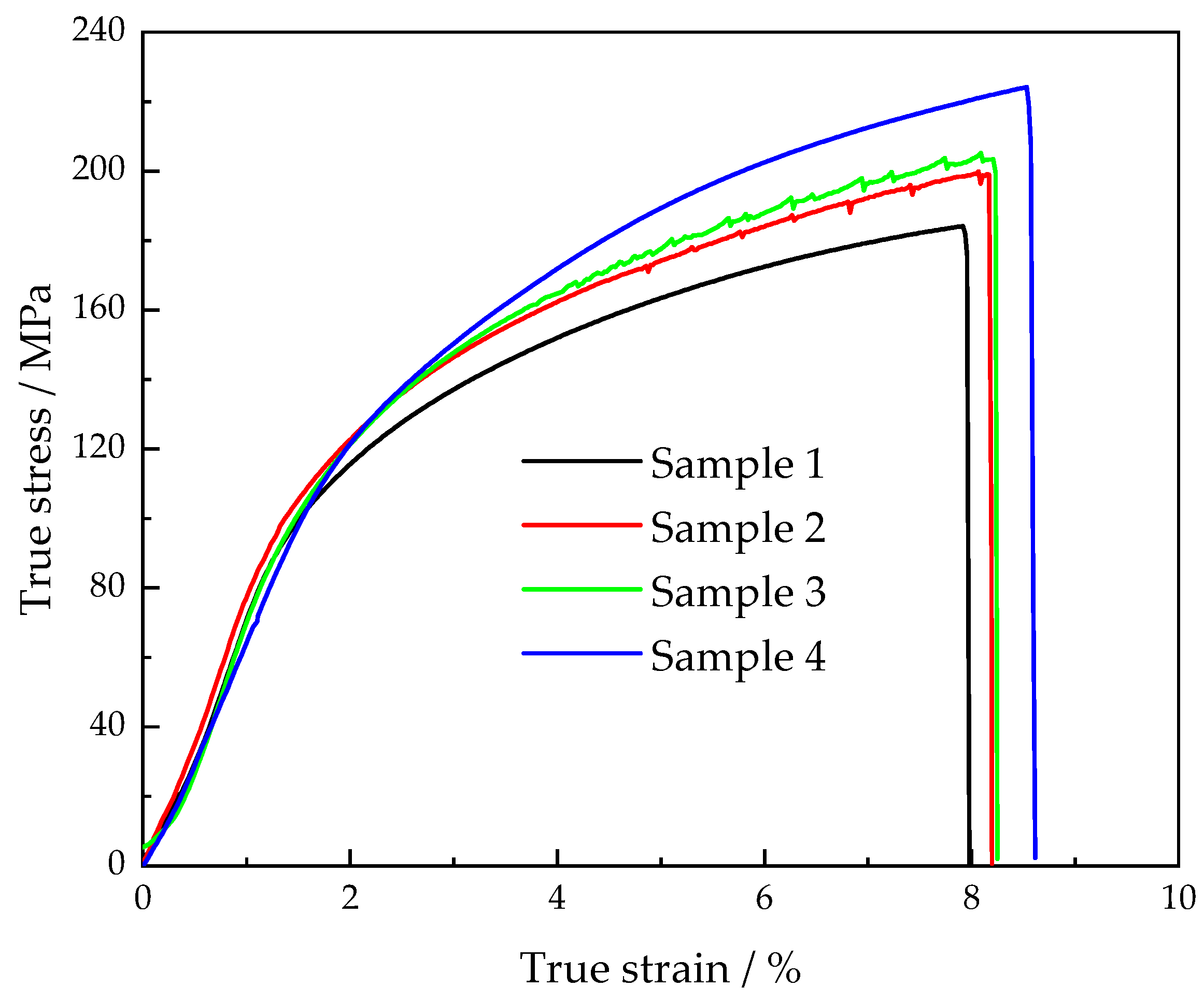
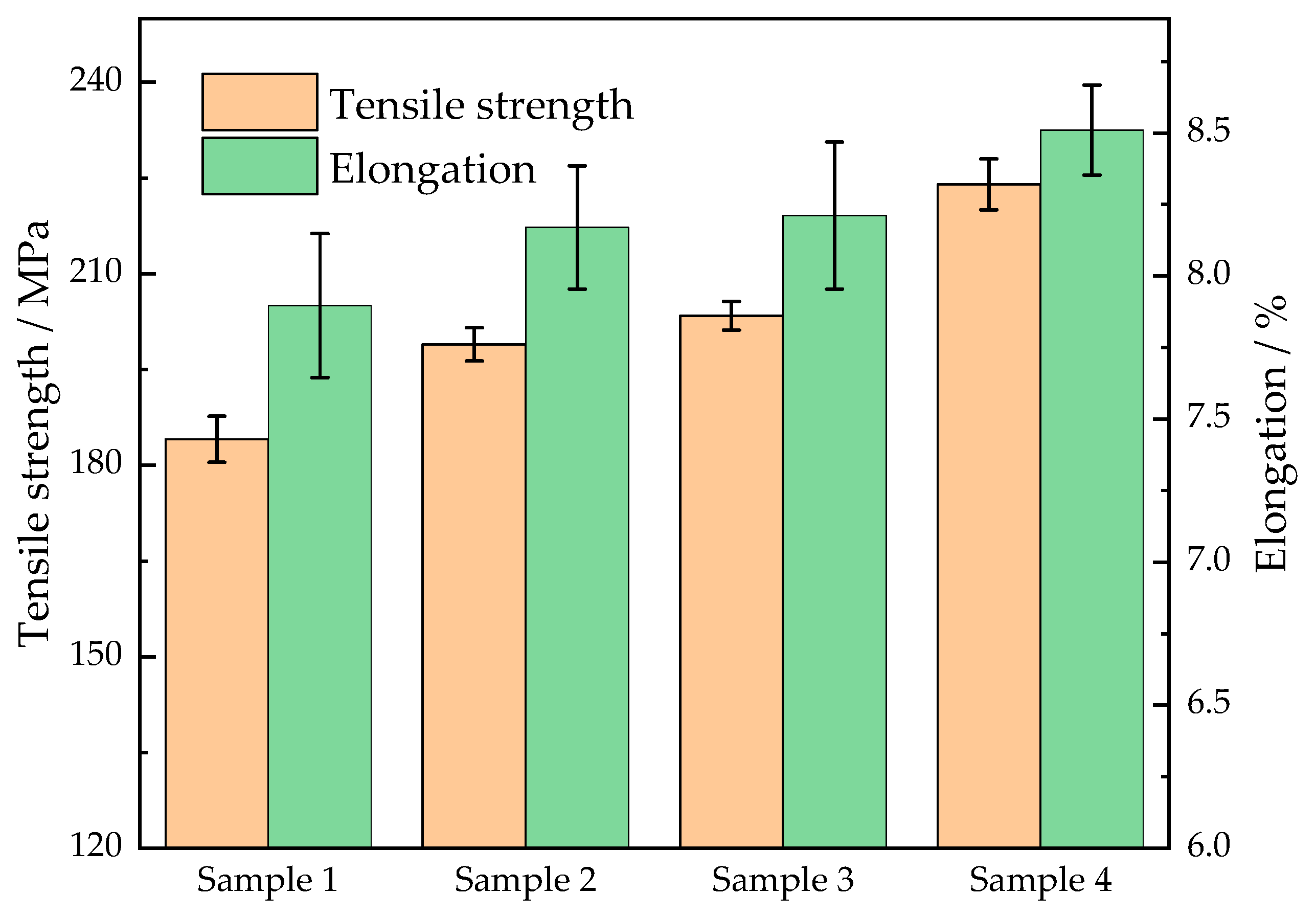

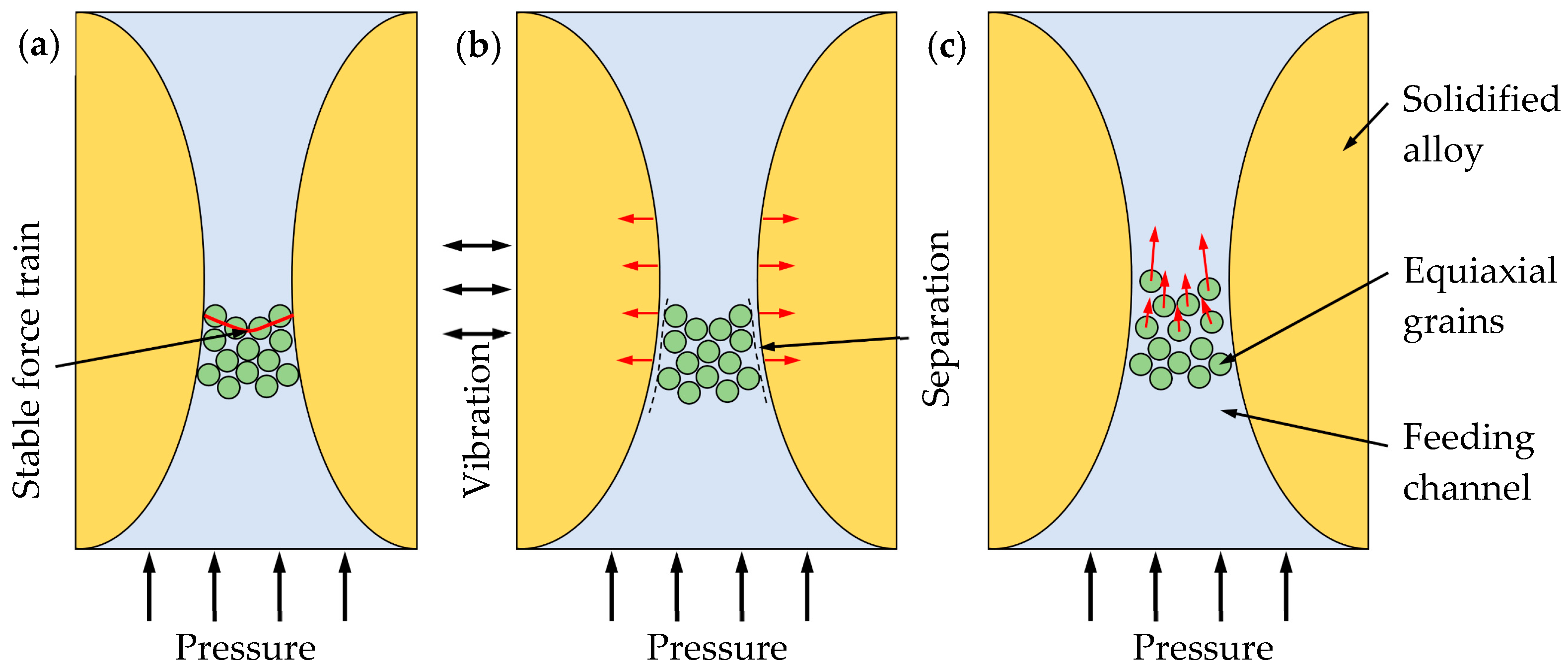
| Cu | Mn | Ti | Zr | B | Cr | V | Al |
|---|---|---|---|---|---|---|---|
| 5.0 | 0.4 | 0.2 | 0.15 | 0.03 | 0.15 | 0.08 | Bal. |
| Castings | Solidification Pressure (kPa) | W/wo Vibration | Frequency (Hz) | Acceleration Amplitude (m/s2) | Displacement Amplitude (mm) |
|---|---|---|---|---|---|
| Sample 1 | 20 | w/o | — | — | — |
| Sample 2 | 40 | w/o | — | — | — |
| Sample 3 | 20 | w/ | 14 | 0.5 | 0.048 |
| Sample 4 | 40 | w/ | 24 | 11.5 | 0.427 |
Publisher’s Note: MDPI stays neutral with regard to jurisdictional claims in published maps and institutional affiliations. |
© 2022 by the authors. Licensee MDPI, Basel, Switzerland. This article is an open access article distributed under the terms and conditions of the Creative Commons Attribution (CC BY) license (https://creativecommons.org/licenses/by/4.0/).
Share and Cite
Chen, W.; Wu, S.; Wang, R. Effect of Mechanical Vibration on the Mechanical Properties and Solidification Feeding in Low-Pressure Sand Casting of Al-Cu-Mn-Ti Alloy. Materials 2022, 15, 8243. https://doi.org/10.3390/ma15228243
Chen W, Wu S, Wang R. Effect of Mechanical Vibration on the Mechanical Properties and Solidification Feeding in Low-Pressure Sand Casting of Al-Cu-Mn-Ti Alloy. Materials. 2022; 15(22):8243. https://doi.org/10.3390/ma15228243
Chicago/Turabian StyleChen, Wei, Shiping Wu, and Rujia Wang. 2022. "Effect of Mechanical Vibration on the Mechanical Properties and Solidification Feeding in Low-Pressure Sand Casting of Al-Cu-Mn-Ti Alloy" Materials 15, no. 22: 8243. https://doi.org/10.3390/ma15228243
APA StyleChen, W., Wu, S., & Wang, R. (2022). Effect of Mechanical Vibration on the Mechanical Properties and Solidification Feeding in Low-Pressure Sand Casting of Al-Cu-Mn-Ti Alloy. Materials, 15(22), 8243. https://doi.org/10.3390/ma15228243





